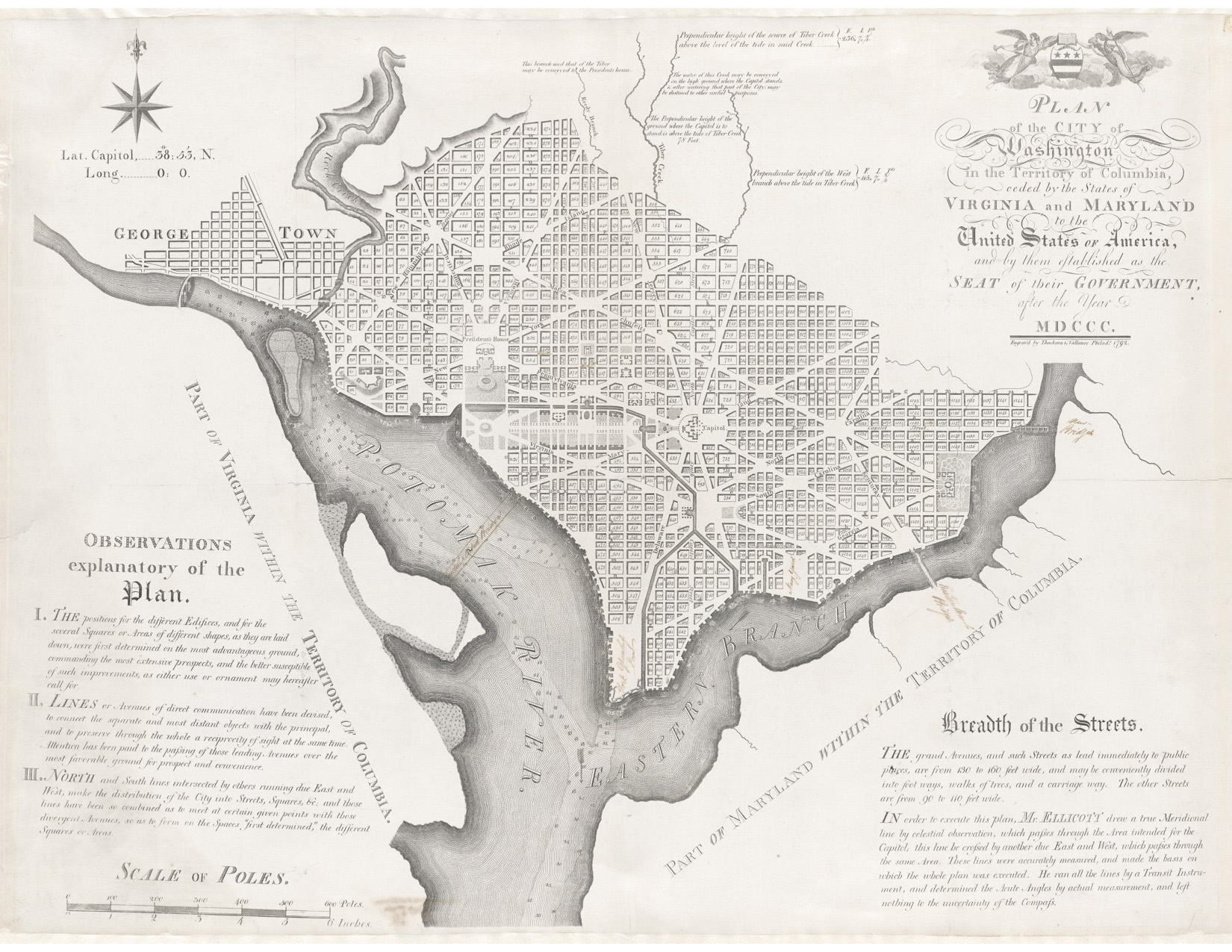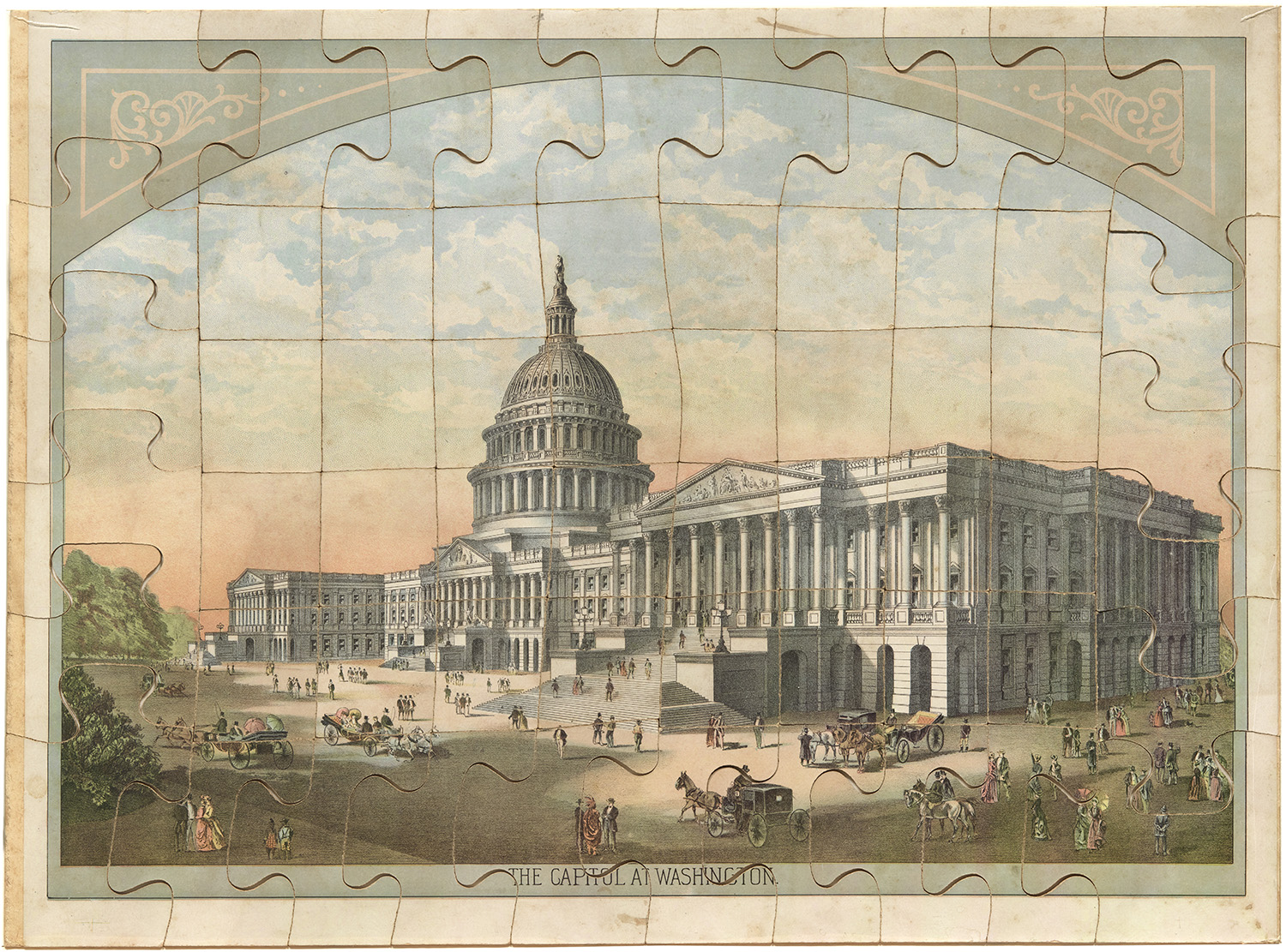
Albert H. Small Washingtoniana Collection
In 2011, Albert H. Small donated his collection of Washington, D.C., memorabilia—sixty years in the making—to the George Washington University. Small hoped that his museum would be valuable for both scholarly inquiry and public appreciation of the rich history of the city.
I wanted to place [the collection] somewhere where it could get the best exposure for people. George Washington is going to set up a program for the study of the collection. And every year another group of students will use it and it will be a continuing thing.
Albert H. Small, 2011
Born in 1925, Albert H. Small grew up in Chevy Chase, Maryland. His father, Albert, was a commercial developer in Washington. Small’s parents also invested in D.C.’s cultural landscape; in honor of their support, the Jewish Historical Society of Greater Washington renamed their historic 1876 synagogue the Albert and Lillian Small Jewish Museum in 1975.“Illustrated History of 1876 Synagogue,” Jewish Historical Society of Greater Washington, accessed July 20, 2018, https://www.jhsgw.org/history/synagogue.
After graduating from Woodrow Wilson High School, Albert Small received a bachelor’s degree in chemical engineering at the University of Virginia and then attended the George Washington University’s law school.John Kelly, “A Capital Collection at GWU Showcases Traces of Washington’s Past,” Washington Post, September 19, 2016, https://www.washingtonpost.com/local/a-capital-collection-at-gwu-showcases-traces-of-washingtons-past/2016/09/19/b9490ad2-7df1-11e6-9070-5c4905bf40dc_story.html. In 1950, Small founded Southern Engineering Corporation, a Washington-based real estate development firm, and has been the company’s president since.
In 1949, Small collected his first Washingtoniana item. While visiting his then-girlfriend and current wife Shirley in Manhattan, Small found a handwritten journal by Fred E. Woodward from 1905. This journal, documenting Woodward’s efforts to restore the boundary stones around the original hundred-mile square of Washington, D.C., sparked Small’s interest in Washington history.Kelly, “Capital Collection at GWU.”
Small began working with Washington historian James M. Goode in 1992. At that time, Small’s collection comprised about two hundred objects.Kelly, “Capital Collection at GWU.” Goode describes Small’s collecting strategy as maintaining “regular communications with dealers about his interests, carefully researching each potential acquisition and the market in general, and being active in the historical community.”James M. Goode, “Civil War Washington: Rare Images from the Albert H. Small Collection,” Washington History 15, no. 1 (2003): 66. Goode has collaborated with Small on several academic projects, drawing selections from Small’s collection for Goode’s books on Washington history.James M. Goode, Washington Images Rare Maps and Prints from the Albert H. Small Collection (Washington, D.C.: Historical Society of Washington, D.C., 2004).
Throughout his life, Small demonstrated his passions for history and education through his philanthropy. Small made a significant donation to his alma mater, the University of Virginia, by funding the construction of the Albert and Shirley Small Special Collections Library. The library, which opened in 2004, houses Small’s collection of 235 documents relating to the Declaration of Independence.Tara Bahrampour, “Colonial History’s Grand Reopening,” Washington Post, November 11, 2004, http://www.washingtonpost.com/wp-dyn/articles/A41140-2004Nov10.html. He also funded the Albert H. Small Documents Gallery in the Smithsonian National Museum of American History, which opened after the museum’s renovations in 2008.Grand Reopening Year, National Museum of American History, 2008, http://amhistory.si.edu/docs/NMAH_reopening_2008.pdf. In 2011, Small established the Normandy: Sacrifice for Freedom Albert H. Small Student & Teacher Institute, which selects fifteen students and fifteen teachers a year to research a soldier who died in the invasion of Normandy, then funds their travels to D.C. and Normandy.“Normandy: Sacrifice for Freedom,” National History Day, accessed July 20, 2018, https://www.nhd.org/normandy-sacrifice-freedom.
Small also sat as the cochair for the Leadership Committee for the short-lived City Museum, which operated from 2003 to 2004 and was funded by the Historical Society of Washington, D.C.Barbara Franco, “The Challenge of a City Museum for Washington, D.C.,” Washington History 15, no. 1 (2003): 18. In collaboration with the museum’s director, Barbara Franco, and with James Goode, Small offered his objects for an exhibit titled Taking a Closer Look: Images from the Albert Small Collection.James M. Goode, “Civil War Washington: Rare Images from the Albert H. Small Collection,” Washington History 15, no. 1 (2003): 66.
Washingtoniana Collection

The Albert H. Small Washingtoniana Collection includes approximately one thousand manuscripts, books, newspapers, broadsides, photographs, postage stamps, paper currencies, and prints and maps. These objects provide primary-source documentation for the formation, development, and history of Washington, D.C., from the eighteenth to the mid-twentieth century.
For years, Small hung his Washingtoniana Collection in his office at Southern Engineering Corporation in Bethesda. In 2011, Small donated his collection to the George Washington University, in addition to funding the renovation of the university’s historic Woodhull House. The Woodhull House serves as the permanent showplace for the collection and is adjacent to the new museum at 21st and G Streets, which houses galleries for the Textile Museum.Jacqueline Trescott, “Albert H. Small Gives Rare Papers to George Washington University,” Washington Post, February 28, 2011, http://voices.washingtonpost.com/arts-post/2011/02/albert_h_small_gives_rare_pape.html. The Woodhull House also houses the Albert H. Small Center for National Capital Area Studies. The center supports diverse academic approaches to the collection, such as American history, geography, and museum studies, and encourages local students and scholars to engage with Small’s collections.“A Historic Gift,” GW Today, February 27, 2011, https://gwtoday.gwu.edu/historic-gift. The museum opened its doors to the public in 2015.
By donating his collection to a university rather than to a historical society or the Library of Congress, Small aimed to make his collection accessible both to the public and to students. When he announced his decision to donate his collection, Small remarked:
I wanted to place it somewhere where it could get the best exposure for people. George Washington is going to set up a program for the study of the collection. And every year another group of students will use it and it will be a continuing thing.Trescott, “Albert H. Small Gives Rare Papers.”
In keeping with Small’s mission for his collection, professors at the George Washington University have given presentations on items sharing a common theme, such as D.C. in the Civil War and the history of city planning. The university holds an annual symposium where students and professors present on individual items in the collection.“Washingtoniana Symposium,” George Washington University Museum, accessed July 20, 2018, https://museum.gwu.edu/washingtoniana-symposium.

Recognition of Albert Small’s Philanthropy
In 2009, President Barack Obama presented Albert Small with the National Humanities Medal. Inaugurated in 1997, the medal honors individuals or groups whose work has deepened the nation's understanding of the humanities and broadened citizens’ engagement with history, literature, languages, philosophy, and other humanities subjects.Jacqueline Trescott, “Obama Honors Leaders in Arts and Humanities, Washington Post, February 26, 2010, http://www.washingtonpost.com/wp-dyn/content/article/2010/02/25/AR2010022504028.html. In 2011, Small also received the President’s Medal from the George Washington University—the highest honor the university’s president can bestow. President Steven Knapp presented the award in recognition of Small’s efforts to enhance national identity and to strengthen cultural and educational opportunities for Americans:
Albert Small’s extraordinary contribution as a collector and preserver of our national heritage will educate countless generations of students, scholars and citizens about the history of our nation and of this great capital city. He is a truly great Washingtonian and an inspiring example of what it means to be a citizen of the United States.“Albert H. Small Awarded George Washington University’s President’s Medal,” George Washington University, June 8, 2011, https://mediarelations.gwu.edu/albert-h-small-awarded-george-washington-university%E2%80%99s-president%E2%80%99s-medal.
In 2015, in celebration of the fiftieth anniversary of the National Endowment for the Humanities, Albert Small received a Lifetime Humanities Achievement Award for his support of the NEH and his contribution to the preservation of Washingtoniana ephemera.Brittney Dunkins, “Albert H. Small Honored with Lifetime Humanities Achievement Award,” GW Today, November 20, 2015, https://gwtoday.gwu.edu/albert-h-small-honored-lifetime-humanities-achievement-award.
Albert Small serves on numerous civic and cultural boards, including those of the National Symphony Orchestra, the National Gallery of Art, the Foundation for the National Archives, the James Madison Council of the Library of Congress, and the National Trust for the Humanities.“Small Awarded President’s Medal.”

Profile by John Lim, 2018 summer intern